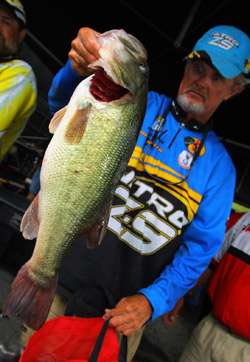
"I can't say I was looking for a giant," said Rick Clunn, 4-time Bassmaster Classic champion. "I was really trying to catch a couple of quality bass. I define those as being between 3 and 5 pounds."
To accomplish that, the Ava, Mo., angler was throwing a white shad finished RC 3.5 deep diving crankbait (Lucky Craft) over a ledge on Friday. His tackle was the usual for Clunn: his Signature Series Bass Pro Shops XPS heavy action 7-foot rod and his Signature Series Bass Pro Shops reel (6.3:1 gear ratio) spooled with 14-pound-test Bass Pro Shops Signature Series Fluorocarbon Line.
"She hit in 8 to 10 feet of water, but that's not the really interesting thing about her and it's not what we should be talking about. What's important about her is the way she was hooked — in the top of the nose and the side of the face — and my ability to land her.
"I land an unusually large percentage of my bass that are face hooked like that. It's because of the round bend hooks that I use on my crankbaits. All modern hooks are sharp and any style will hook a bass securely if it's inside their mouth. There's never a problem with that.
"But, when they're hooked on the outside, the round bend is what makes the difference. It penetrates securely and holds. That's why I land so many of them compared to the other anglers."
Exactly why bass slap at crankbaits remains a mystery, even to someone as studious as Clunn. Nevertheless, he offers two theories that might help to explain the phenomenon.
1. They are trying to disperse the shad school so that all the other bass have a chance to isolate and capture something to eat.
2. Perhaps they don't want to eat it. Maybe all they want to do is kill it. Bass are predators, after all. It's what they do.
Regardless, Clunn strongly recommends round bend hooks on crankbaits. "That's why I got her to the boat and why I'll get more like her to the boat before the season's over," he says, leaving no doubt about his opinion on the subject.




